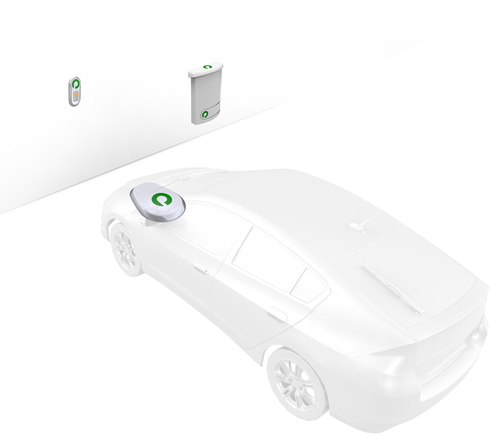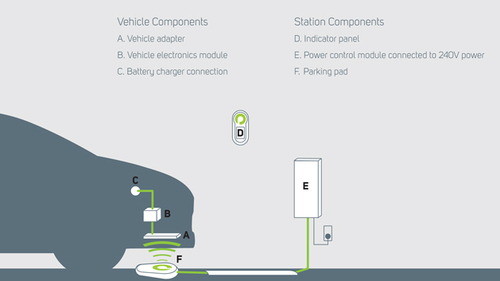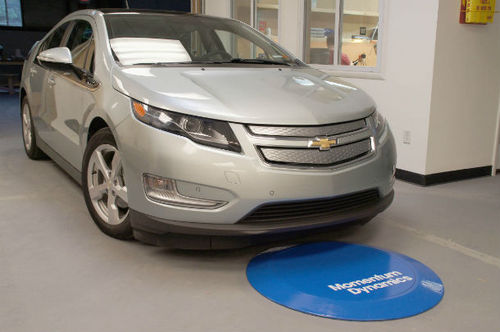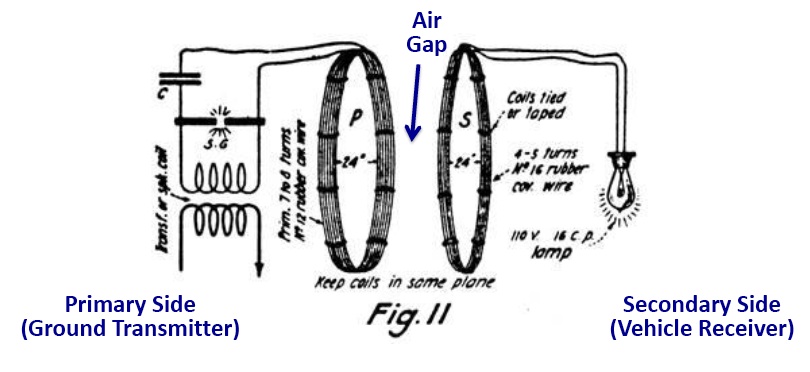Wirelessly charging stationary electric cars
By:
+David Herron; Date: 2021-01-03T23:53:30.285Z
Tags: EV Charging »»»» Wireless Charging »»»» TBD
The electric vehicle industry has gone through a major process to get to a single standard to charge electric cars with a wired connection. Namely, the J1772 standard for AC Level 2 charging. Fast charging is still not a settled standard in that there are competing methods to implement fast charging.
However, for better or worse, some want to do away with wired charger connections. Instead they want to charge the cars without wires, using some sort of wireless electricity transmission.
This page covers wireless charging of cars at a fixed location, at a charging station which supports wireless charging. The researchers are also working on TBD: Fix This: [[[ Electric Roads wirelessly charging electric cars while driving ]]]
Companies: Evatran
Makes a product that supports wireless charging of electric cars that have J1772 ports. The receiver installs on the car, connecting to the J1772 port, and the transmitter is placed on the ground where the car will park. (
see pluglesspower.com)
With Plugless Power, you simply park your EV and it charges. You'll never again worry if you remembered to plug it in, or fight with a heavy, dirty power cord in a cluttered garage or crowded parking lot.
They claim these are the advantages: (
see pluglesspower.com)
- Just park and charge: Simply park your EV over the Plugless Power parking pad, and it starts charging right away. There are no buttons to push or cords to plug in.
- Remove another worry: You've usually got a lot going on when you get home. The last thing you want is another thing to add to your routine like plugging the car in.
- Enjoy total charging convenience: With automatic wireless charging from Plugless Power, you can charge your vehicle without getting your hands dirty in snow, rain, cluttered garages, and crowded parking lots.
- Count on proven reliability: Simple, dependable EV charging equipment backed by years of electrical industry experience leads to safe, hassle-free charging of your electric vehicle.


Companies: Momentum Dynamics
Momentum Dynamics is a start-up clean technology company located in Malvern, PA. The company is developing a unique and proprietary technology system that will permit electrically powered vehicles to be recharged without the use of a wire. This wireless technology is revolutionary because it can be operated automatically, allowing both passenger-class and commercial fleet vehicles to be charged safely and effortlessly in all weather and without direct supervision.
There is the need to extend Battery Electric Vehicle driving range as well as a need to extend the life of the vehicle battery by preventing frequent deep discharging. Our system solves both problems by making vehicle charging so effortless that it can be accomplished on the fly.
The Momentum Dynamics system is designed as a suite of hardware and software. The hardware allows large amounts of power to be transmitted efficiently through air gaps up to 24 inches. This is the gap between pavement surface and the underside of a vehicle. The software allows the system to operate safely and automatically, enables bi-directional communication between the ground- and vehicle based hardware, permits sales of power to be reliably transacted, and causes the system to operate as an intelligent node on the emerging smart grid. This last feature is essential to early adoption as it automatically works to load-balance electrical demand to prevent overloading of the power grid and local transformers.

- Our system is wireless and able to work efficiently with vehicles that have high ground clearances.
- The technology concept is highly efficient because it is optimized for automotive applications rather than for general charging.
- It is automatic. No plug-in system can match this capability. As such, it makes recharging so convenient that drivers can "charge and go" with less thought and effort than they are conditioned to for fueling gasoline vehicles. Drivers cannot forget to charge their vehicles.
- Our wireless charging system can be operated in any weather, and is immune to vandalism, theft, misuse and abuse. It does not need to be supervised in the way that plug?in chargers must be.
- Our system can significantly reduce charging times at moderate voltages.
- The Momentum Dynamics system is vehicle?agnostic, so any OEM can adopt it.
- Precise vehicle positioning is not required.
- How does the system work? The system employs closely-coupled magnetic resonance. This is to be distinguished from nonresonant induction of the type that is commonly seen in cell?phone recharging pads. In our system, two matched coils, a transmitter that is connected to the electrical grid and located on or in the pavement, and a receiver, which is installed in the vehicle, operate as a set. The transmitting coil is tuned to create an alternating magnetic field of a specified frequency. The receiving coil is also tuned to this frequency, and as the transmitter is energized, the receiving coil has a current induced within it, even though the two coils are not in contact with each other and separated by up to two feet. When the coils resonate at exactly the same frequency they can transfer power very efficiently. The key, however, is to keep both coils in resonance, and to do this we employ a proprietary electronic control system. Our system is designed to be embedded within pavement and can be affordably manufactured. In the Momentum Dynamics system, any transmitting coil can work with any receiving coil, and the system itself can be adapted to any type of vehicle. Proprietary software and built-in wireless communication technology allows the system to recognize receiving coils that are eligible for power transmission (the key to automatic transactions), and to dynamically adjust to bring the coils into resonance.

- How will the system be deployed? Charging locations can be at retail parking lots, office buildings, parking garages, malls, schools, sports arenas and theme parks -- wherever people park their cars. During short stops -- for example during a visit to a supermarket -- a driver can simply park in an equipped wireless charging space, leave their vehicle, conduct their business, and return to continue driving. Without so much as pressing a button, the vehicle will be recognized and authorized by the system software, and the wireless transmission of power will commence. Whether the stop is for 5 minutes or an hour -- in this period of time the vehicle will receive an intermittent power upcharge to augment the battery charge state. In this manner, the new power allows driving range to be vastly extended and deep?discharging of the battery is prevented.
The company is focused on the commercial fleet market. (June 2012)
- Battery-electric commercial trucks
- Anti-idling & "shore power" for conventional ICE vehicles
- Light trucks & passenger vehicles

CLAIM:
- Wired charging: Efficiency 96% Cost approx $0.85 / kW
- Wireless charging: Efficiency 91% Cost approx $0.33 / kW
Under development:
- 3 kW - Targeted at residential / cars -
- 10 kW - Targeted at cars and light commercial - Pilot projects in Pennsylvania, California
- 30 kW - Targeted at medium duty commercial trucks - Pilot projects in Pennsylvania, California, Germany
Planned:
- 60 kW - Targeted at Heavy duty commercial vehicles, including buses
- 100 kW - "all" commercial vehicles
Consider a scenario of an airport shuttle bus. There are several manufacturers of these (such as Smith Electric Vehicles, and Balqon). These buses drive around in a loop all day long, stopping at the same stops over and over and over.
According to Momentum Dynamics, a bus in this scenario that isn't being recharged throughout the day will run out of juice in an hour or two. Obviously the fleet operator will want to keep the bus on the road for more hours than that. Momentum Dynamics wireless recharging pads could be installed at each of the stops. As the bus pulls up to the stop, all the driver has to do is make sure s/he parks on top of the pad, and the bus will immediately start charging. MD claims that with a short recharge at frequent intervals throughout the day, the bus can simply keep running all day long relying on those brief charges to get enough juice to keep going.
Alternative powertrain technologies - Current trends in wireless power - June 12, 2012 (registration required) - Slides of a presentation made by Andy Daga, CEO, Momentum Dynamics at Commercial Vehicle Megatrends USA 2012. -
automotiveworld.com
Momentum Dynamics Promises Fast and Easy Wireless EV Charging - JUNE 14, 2012 -
hybridcars.com
Tech company equips Chevrolet Volt with wireless charging system; fleet expected later this year - June 14, 2012 -
mlive.com
Wireless electric car charging demo on Chevy Volt could enable 24/7 electric trucks - June 14, 2012 -
torquenews.com
Companies: Witricity
This company is working generally on "Wireless Electricity Delivered Over A Distance". One of their products is little charging pads for mobile devices, and the other product is an electric car charging station.
witricity.com
The WiT-3300 Deployment Kit is a wireless "Park-and-Charge" self-charging system for electric vehicles. The system provides an efficient wireless energy transfer solution that completely avoids the need for the driver to plug in their battery electric vehicle or PHEV.
The WiT-3300 Deployment Kit is designed to transfer energy over distances ranging from 10-20cm, and custom configurations can be provided for vehicles having higher or lower ground clearance. Wireless energy transfer can occur through any non-metallic material, which means that the source device can be installed beneath a garage floor or paved parking space.
||~ Attribute ||~ Specifications || || Operating Frequency || 145 kHz, nominal || || Lateral Positional Tolerance || �20 cm in vehicle side to side axis; �10 cm in vehicle bumper to bumper axis || || Output Power || DC: 300 watts-3.3 kilowatts, continuously variable || || Output Voltage || DC: 350 VDC- 400 VDC at 3.3 kW, 18 cm resonator-resonator distance || || Source Module Enclosure || 50 cm x 50 cm x 3.75 cm; 12.5 kg || || Capture Module Enclosure || 50 cm x 50 cm x 3.75 cm; 12.5 kg || || RF Amplifier Assembly || 22 cm x 33 cm x 13 cm; 4.2 kg || || On-Vehicle Rectifier Assembly || 20 cm x 28 cm x 7 cm; 3.6 kg ||
